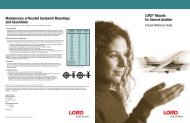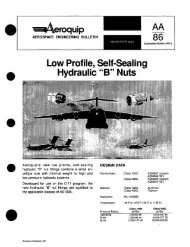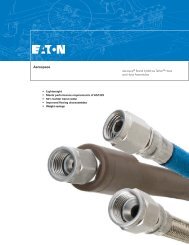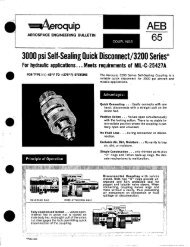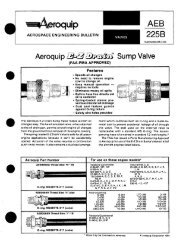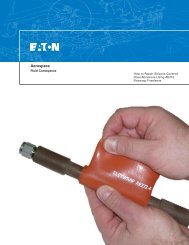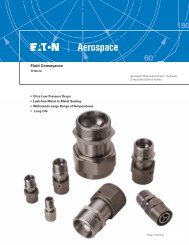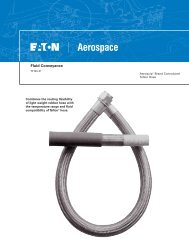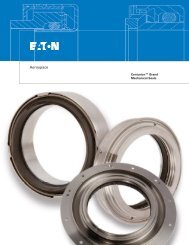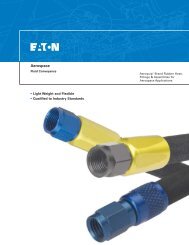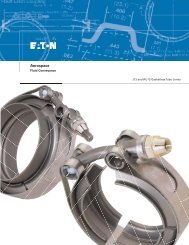Rubber Hose Fittings & Assy_TF100-16A_4-22-05 ... - Herber Aircraft
Rubber Hose Fittings & Assy_TF100-16A_4-22-05 ... - Herber Aircraft
Rubber Hose Fittings & Assy_TF100-16A_4-22-05 ... - Herber Aircraft
You also want an ePaper? Increase the reach of your titles
YUMPU automatically turns print PDFs into web optimized ePapers that Google loves.
<strong>Aircraft</strong> <strong>Rubber</strong> <strong>Hose</strong> Assembly Instructions<br />
306, 303 and 302A <strong>Hose</strong><br />
Step 1.<br />
Cut hose squarely to length. Use<br />
hose cut-off machine or fine tooth<br />
hacksaw. Do not remove the cover<br />
if using a hacksaw; wrap hose<br />
with several layers of tape before<br />
cutting.<br />
Step 2.<br />
Place socket in vise. Do not overtighten<br />
vise on thin walled sockets<br />
of lightweight fittings. Screw hose<br />
counter-clockwise into socket until<br />
it bottoms. Back off 1/4 turn.<br />
Step 3.<br />
Tighten nipple and nut on<br />
assembly mandrel. The use of<br />
Aeroquip brand S1<strong>05</strong>1 hand<br />
assembly tools are recommended<br />
to avoid damage to the sealing<br />
surface and to properly support<br />
the inner tube.<br />
Step 4.<br />
Lubricate inside of hose and<br />
nipple threads liberally. Use<br />
lubricating oil, petrolatum or light<br />
grease.<br />
Step 5.<br />
Screw nipple into socket and hose<br />
using wrench on assembly tool<br />
hex. Nut must swivel freely when<br />
assembly tool is removed.<br />
Maximum allowable gap between<br />
nut and socket is 1/16”. On -32<br />
screw in until turning becomes<br />
difficult, back out nipple,<br />
relubricate and reassemble.<br />
Elbow <strong>Hose</strong> Assemblies - 303 and 302A<br />
Step 1.<br />
Cut hose squarely to length. Use<br />
hose cut off machine or fine tooth<br />
hacksaw. If using a hacksaw, wrap<br />
hose with tape before cutting. Do<br />
not remove cover.<br />
Step 2.<br />
Place socket in vises. Do not overtighten<br />
vise on thin walled sockets<br />
of light weight fittings. Screw hose<br />
counter-clockwise into socket until it<br />
bottoms. Back off 1/4 turn.<br />
Step 3.<br />
Flange elbow fittings. Drop flange<br />
over threaded end of nipple. Nipple<br />
shoulder must fit into counter bore<br />
of flange.<br />
Step 4.<br />
Lubricate inside of hose and nipple<br />
threads liberally. Use lubricating oil,<br />
petrolatum or light grease.<br />
Step 5.<br />
Screw nipple into socket and hose<br />
using wrench on elbow hex. Tighten<br />
until hex is snug against socket. On -<br />
32 and larger sizes, screw in until<br />
turning becomes difficult, back out<br />
nipple, relubricate and reassemble.<br />
Step 6.<br />
Adjustments may be necessary to<br />
obtain the desired position angle<br />
between two elbows. In order to<br />
minimize backing off elbows to<br />
position, the following procedure<br />
should supplement Step 5.<br />
A. Tighten both elbows to maximum<br />
allowable gap (reference Step<br />
6C), then start to position for<br />
relative angle between the<br />
elbows.<br />
B. Finish assembly by adjusting both<br />
elbows. Backing-off to position<br />
should be avoided and in no case<br />
should exceed 1/4 turn.<br />
C. Maximum allowable gap between<br />
nipple hex and socket is 1/16”<br />
using 303 and 302A hose.<br />
EATON CORPORATION Aerospace <strong>TF100</strong>-<strong>16A</strong> May 20<strong>05</strong> 7



